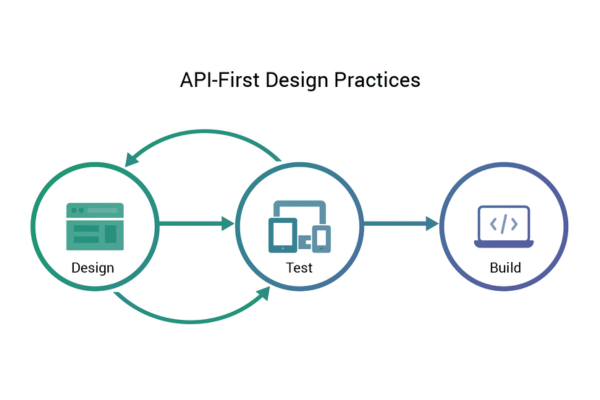The Surge in API-First Architecture: What It Means for the Future of Content Platforms

With digital experiences becoming more and more interconnected, more and more organizations are leveraging an API-first strategy for their content platforms. This increase in API-first content platforms points to a transition in how companies see content and delivery. The advantages of an API-first content platform flexibility, speed to market, and enhanced customer experience are impressive. This article explores the rising excitement around API-first architecture and its future implications for content platforms.
What Does API-First Mean?
When we say that an application is built with an API-first approach, it means that the application programming interface is created first. Where previously applications were developed using a user interface and backend that were coupled (meaning both systems were so dependent on each other that they worked to render one final product), APIs decouple how content and data are managed versus how it’s presented.
Headless CMS platforms like Storyblok exemplify this approach, providing APIs designed to enable seamless integration and dynamic content delivery. This makes content platforms more flexible to integrate with front-end applications and third-party applications, improving scalability, flexibility, and interoperability within the larger digital ecosystem.
Why Is It Important?
For developers, working in an API-first environment allows them to work faster. When content management is effectively already coupled to the user experience layer, a development team must create a user interface that works according to a timeline that’s already attached to a competent structure. An API-first approach allows for independent user interface development that’s able to iterate and be improved upon in real time without deferring to the underlying structures.
This allows for independent timelines for development that are more conducive to innovation and more accessible time to market for multiple projects. Organizations can take advantage of various developments championed by new and emerging technologies think artificial intelligence, for example, or new developments within voice-enabled assistants and quickly experiment with new implementations without needing to re-platform or completely overhaul existing processes.
How Does It Impact Customers?
Customers today expect a cohesive content experience regardless of whether they’re interacting with a website, mobile device, voice-assisted capabilities, IoT technologies or digital kiosks. An API-first environment promotes this type of omnichannel exposure because whatever content is needed can be delivered on an API that makes it functional across multiple platforms.
As a result, organizations that can provide an API-first experience can more effectively facilitate the consistent experience they want to deliver, no matter how they interact with their customers.
Improving Integration and Interoperability

An API-first approach makes integration simpler and faster. Businesses can integrate different solutions on the fly and build their own composable tech stacks. APIs are often standardized, which means that integration components between different systems output and input from content management systems to e-commerce and analytics to marketing automation do not require excessive development time to connect.
The need for standardization means universal connections reduce developmental challenges while increasing go-to-market speed, making it easier for disparate systems to connect and add to a larger digital ecosystem that can be adjusted more easily to changes in demand.
Encouraging Scalability and Performance
For growing businesses or companies with busy seasons throughout the year, scalability is essential. An API-first approach encourages scalability and performance thanks to its modular design that allows systems to scale in development without sacrificing the quality of performance.
For example, those focused more on content can better scale and manage either additional content creation or larger volumes of traffic and users without negative response times. The ability to keep performance at an even level consistent with user experience quality even during guaranteed demand sets businesses in their best position for easy management of future growth.
Favoring Content Teams and Marketers
API-first architectures deliver many benefits for content creators. For one, they separate the back end from the front end, meaning content creators do not have to worry about what the technical team is doing on their side and vice versa. This independence fosters faster time-to-market for both content and development; content teams can adhere to timelines and foster quicker turnarounds without waiting for front-end elements to be completed.
Simultaneously, the marketing teams appreciate this as it allows for quicker feedback and implementation, as content creators can simultaneously work on their portion while the technical team integrates other features. Thus, this separation champions faster successes for those sensitive to marketing needs.
Future-Proofing Digital Investments
In a world where technology is always advancing at a rapid pace, companies need systems/solutions that will grow with them and be adaptable. An API-first architecture inherently meets future needs as it easily interfaces with new technologies and new digital channels. Companies already playing catch-up with technology and system development will find it easier to integrate API-first solutions as their foundations will have been developed to create ecosystems to exist functionally and relevant down the line.
Therefore, from this standpoint, API-first also reduces the need for future investments as companies are less likely to experience disruptions with future developments and more inclined to find a steady stream of opportunity to remain pertinent and functional.
Boosting Developer Experience and Efficiency
Developer experience is better with API-first since they are easy to understand and work with if well-documented as an API than poorly thought-out features of a traditional, monolithic system. Developers onboard quickly, effectively integrate standardized offerings into their projects, and avoid the headaches that come with complicated interactions with ununified, monolithic systems. When developers experience better outcomes, better projects are developed due to effective productivity, efficient usability, and enhanced job satisfaction and it’s true that happier developers generate better results.
Allowing Instant Updates and Responses
In any application requiring critical access, users expect instantaneous communication; they expect fluid experiences and engagement. The easiest way for an enterprise to ensure they can meet such expectations is to build the architecture necessary to support such requirements from the start.
An API-first architecture allows for real-time updates and engagement through instant content delivery and rapid interactivity between front ends and back-end platforms.
Companies can change critical elements in seconds and ensure that they’re updated in real-time and uniformly across every application and digital presence, allowing for effective communication and engagement and increasing brand authority and user experiences.
Strengthening Security and Compliance Initiatives
With many companies going digital, security and compliance factors are increasing. The API-first development architecture helps with security and compliance efforts because an API is a uniform way of interacting with an entity’s data. Therefore, companies are able to implement compliance factors, from authentication and authorization to data governance, in one place via an API.
Not to mention, with compliance requirements like GDPR and CCPA requiring companies to be even more conscientious about personal data and customer privacy, increasing the ability to secure customer information boosts customer trust and reduces liability exposure should a security issue occur.
Easing Up on Maintenance and Lowering Technical Debt
Enterprise solutions come with some of the biggest technical challenges concerning maintenance and technical debt. Yet the API-first architecture helps fight these challenges relatively easily. Because the API-first architecture is highly modular, companies can update and even swap out pieces of their solution without having to reconfigure the entire solution every time.
Therefore, this reduces technical debt over time and makes maintenance less troublesome over the years, ultimately saving companies money in operational expenses over time.
Companies are more equipped with healthier solutions with less anticipated debt over time since companies remain flexible and adaptive as opposed to being stuffed with unnecessary redundancies.
Promoting Greater Collaboration between Departments
When companies decide to go with an API-first approach, it creates better synergy for teams across departments, whether the development team and marketing or content and operations. Since APIs are standardized operating instructions and controls for what something will do, communication becomes easier when clear expectations are standards.
Therefore, improved collaboration leads to more effective delivery for project timelines and overall productivity toward shared goals, enabling companies to deliver more consistently and cohesively digital experiences on time.
Reducing Timeframes for Digital Transformation
Digital transformations require frameworks that are flexible, adaptable, and scalable. An API-first architecture reduces timeframes for digital transformation by enabling companies to transition from legacy infrastructures into new agile systems.
Companies benefit from rapid deployment, staggered implementations, and decreased downtimes, establishing reduced timeframes that effectively shorten the effort for transformation. An API-first architecture encourages continual integration and the fast pivot to digital-first expectations so that companies never fail to have the competitive edge needed in digital markets.
Ultimately, the trend toward API-first architecture is a rapid foundational change into flexible, interlinked systems that are easier to adapt to, especially for this digital-first marketplace. Companies set themselves up for success in effective integration and ever-present implementation and access to digital content with an API-first architecture. The more this trend becomes solidified, the more this API-first approach will reign supreme in the future of any content management system.
Better Analytics for Data Decision-Making
An API-first architecture gives companies better analytics due to a better flow of data. With established connections with other applications AI, machine learning, analytics, business intelligence tools APIs can easily push and pull data structured and unstructured where it needs to go.
Companies can assess how well their application/content works with other applications through onboard real-time metrics or through access to other applications that house such information. This achievement supports solid analytics for data-driven decisions that allow companies to suggest min-max efforts for successful projects.
Speed-to-Market for New Digital Initiatives
Speed is everything in a competitive digital market, and having an API-first architecture increases speed-to-market for new digital initiatives. APIs create modular, ready-made components that development teams can use repeatedly with no extreme custom coding required per initiative.
This efficiency reduces development turnarounds incredibly and allows companies to foresee market needs/devices faster. In turn, speed-to-market through rapid evolution powered by an API-first architecture can give any company a competitive advantage as its new features or content can be presented to its consumer base at a pace no one else can achieve.
Enhancing Customer Experience with Dynamic Personalization
Dynamic personalization is a great source of competitive advantage for better customer experience because the world is so digital-first and consumers expect general content to engage, be appealing, and then also, be tailored to them in real-time. Having access to and being able to distribute such specific information on demand, and at scale, is easiest with API-first architectures which, by their design, encompass all elements of flexibility and real-time utilization.
APIs application programming interfaces facilitate seamless, instantaneous engagement between a single-source content repository, customer interaction data, analytics, and the platforms through which users engage with brands online. Within this connected ecosystem, every time a person engages with one piece of the puzzle, for example, thousands of bespoke responses can happen throughout the system in seconds.
For instance, if someone clicks to read an article on a brand’s website and then clicks away to another unrelated site, that next site could be another brand utilizing API technology for customization. That person could be served ads about where they were before, where they are now, their general search history on that device, even geo-targeted information based on where the person is physically located.
The structured data for real-time exchange allows brands to provide more genuine suggestions, savings offers, and content opportunities. Audiences are met with online experiences that matter more, appealing to aspects of human interaction and engagement so that people pay attention more.
Dynamic personalization makes audiences much happier because of this live, almost AI-type experience as well. Customers enjoy when brands offer content they’re already seeking and looking forward to when they get personalized, like-minded experiences across multiple digital engagements, brands create credibility.
For example, if audiences see a brand always opts for a certain percent off or a type of promotion because it aligns with customer-type expectations, these elements make audiences care more about these brands. Thus, API-first for dynamic personalization allows for stronger connections over time.
























